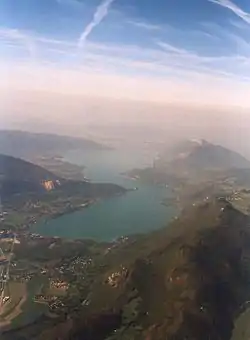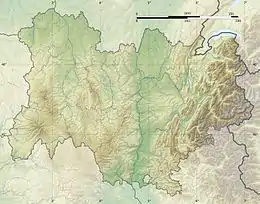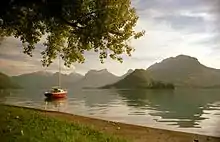Lake Annecy
Lake Annecy (French: Lac d'Annecy) is a perialpine lake in Haute-Savoie in France.[2]:958
| Lake Annecy | |
|---|---|
 With labels for towns and mountains | |
 Lake Annecy | |
| Location | Haute-Savoie |
| Coordinates | 45°51′N 6°10′E |
| Native name | Lac d'Annecy (French) |
| Primary inflows | Ire, Eau morte, Laudon, Bornette and Biolon |
| Primary outflows | Thiou |
| Catchment area | 251 km2 (97 sq mi) |
| Basin countries | France |
| Max. length | 14.6 km (9.1 mi) |
| Max. width | 3.2 km (2.0 mi) |
| Surface area | 27.59 km2 (10.65 sq mi) |
| Average depth | 41 m (135 ft) |
| Max. depth | 82 m (269 ft) |
| Water volume | 1,124.5 million cubic metres (911,600 acre⋅ft) |
| Residence time | 4 years |
| Surface elevation | 446.97 m (1,466.4 ft) |
| Settlements | Annecy (see list) |

It is the third largest lake in France, after the Lac du Bourget and Lac de Grand-Lieu, if the French part of Lake Geneva (which is shared between Switzerland and France) is excluded. It is known as "Europe's cleanest lake" because of strict environmental regulations introduced in the 1960s. It is a popular tourist destination known for its swimming and water sports.
The lake was formed about 18,000 years ago, at the time the large alpine glaciers melted. It is fed by many small rivers from the surrounding mountains (Ire, Eau morte, Laudon, Bornette and Biolon), and from a powerful underwater source, the Boubioz, which enters at 82 m depth.
Towns and villages around the lake
- Annecy
- Annecy-le-vieux
- Veyrier-du-Lac
- Menthon-Saint-Bernard
- Talloires
- Doussard
- Duingt
- Saint-Jorioz
- Sévrier
A cycle path goes partially around Lake Annecy past Sevrier and St Jorioz to Ugine. It has an aim to reach Albertville. The lake is around 14 km long.
 View of Lake Annecy from Talloires.
View of Lake Annecy from Talloires. Paul Cézanne. Le lac bleu, 1896.
Paul Cézanne. Le lac bleu, 1896. Lake Annecy, with the mountains of Dents de Lanfon, Lanfonnet and La Tournette in the background.
Lake Annecy, with the mountains of Dents de Lanfon, Lanfonnet and La Tournette in the background.
See also
References
- "Activity Weekend in the French Alps". Blue Ocean. Retrieved 2020-12-10.
- Jean-Daniel Stanley and Thomas F. Jorstad, Direct Sediment Dispersal from Mountain to Shore, with Bypassing via Three Human-Modified Channel Systems to Lake Annecy, SE France (2004) Vol 20 (4) Journal of Coastal Research pp 958 - 969 JStor.
![]() This article incorporates text from a publication now in the public domain: Chisholm, Hugh, ed. (1911). "Annecy". Encyclopædia Britannica. 2 (11th ed.). Cambridge University Press. p. 72.
This article incorporates text from a publication now in the public domain: Chisholm, Hugh, ed. (1911). "Annecy". Encyclopædia Britannica. 2 (11th ed.). Cambridge University Press. p. 72.
Further reading
- Jean-Daniel Stanley and Thomas F. Jorstad, Direct Sediment Dispersal from Mountain to Shore, with Bypassing via Three Human-Modified Channel Systems to Lake Annecy, SE France (2004) Vol 20 (4) Journal of Coastal Research pp 958 – 969 JStor.
External links
| Wikimedia Commons has media related to Lake Annecy. |